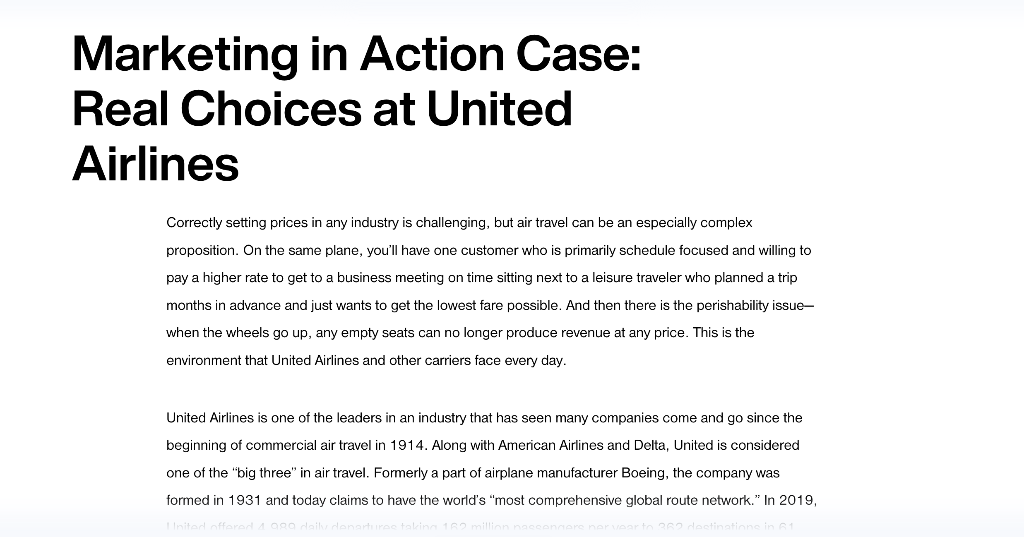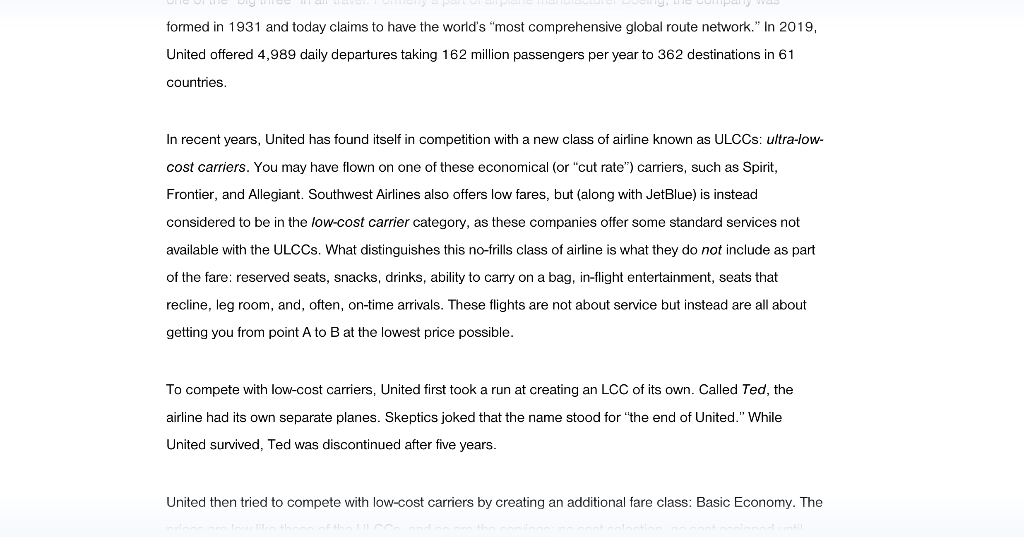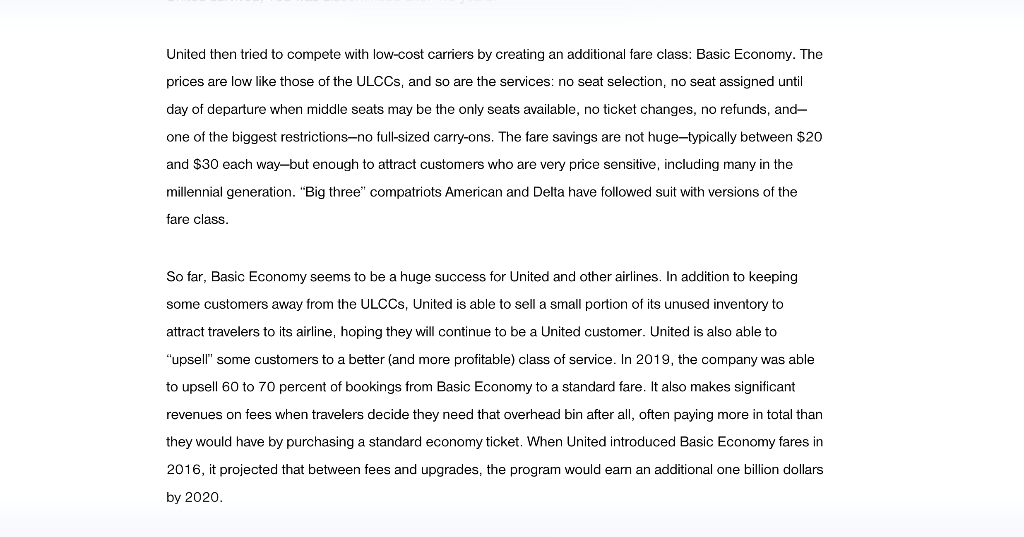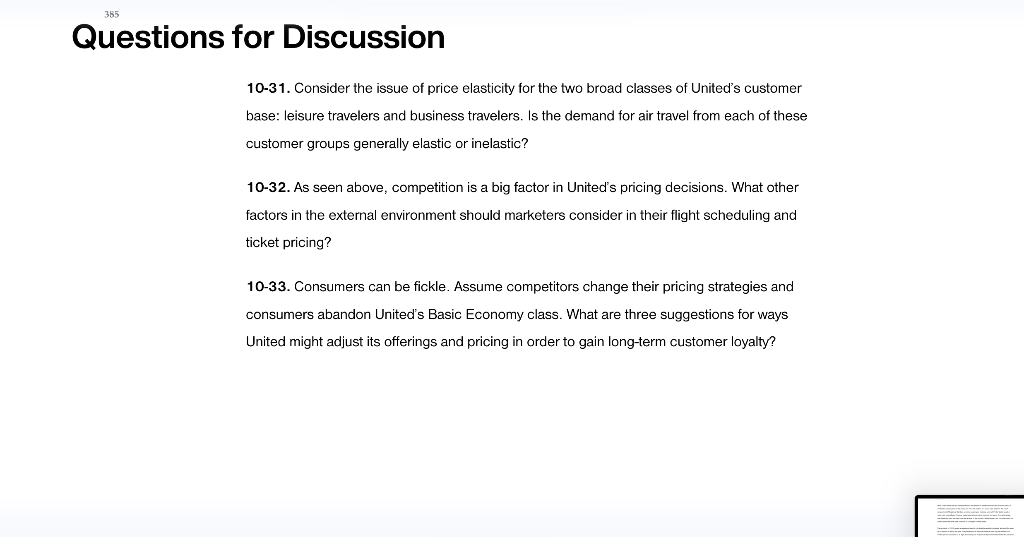




Marketing in Action Case: Real Choices at United Airlines Correctly setting prices in any industry is challenging, but air travel can be an especially complex proposition. On the same plane, you'll have one customer who is primarily schedule focused and willing to pay a higher rate to get to a business meeting on time sitting next to a leisure traveler who planned a trip when the wheels go up, any empty seats can no longer produce re environment that United Airlines and other carriers face every day. United Airlines is one of the leaders in an industry that has seen many companies come and go since the one of the "big three" in air travel. Formerly a part of airplane manufacturer Boeing, the company was formed in 1931 and today claims to have the world's "most comprehensive global route network." In 2019 formed in 1931 and today claims to have the world's "most comprehensive global route network." In 2019, United offered 4,989 daily departures taking 162 million passengers per year to 362 destinations in 61 countries. In recent years, United has found itself in competition with a new class of airline known as ULCCs: ultra-lowcost carriers. You may have flown on one of these economical (or "cut rate") carriers, such as Spirit, Frontier, and Allegiant. Southwest Airlines also offers low fares, but (along with JetBlue) is instead considered to be in the low-cost carrier category, as these companies offer some standard services not available with the ULCCs. What distinguishes this no-frills class of airline is what they do not include as part of the fare: reserved seats, snacks, drinks, ability to carry on a bag, in-flight entertainment, seats that recline, leg room, and, often, on-time arrivals. These flights are not about service but instead are all about getting you from point A to B at the lowest price possible. To compete with low-cost carriers, United first took a run at creating an LCC of its own. Called Ted, the airline had its own separate planes. Skeptics joked that the name stood for "the end of United." While United survived, Ted was discontinued after five years. United then tried to compete with low-cost carriers by creating an additional fare class: Basic Economy. The United then tried to compete with low-cost carriers by creating an additional fare class: Basic Economy. The prices are low like those of the ULCCs, and so are the services: no seat selection, no seat assigned until day of departure when middle seats may be the only seats available, no ticket changes, no refunds, andone of the biggest restrictions-no full-sized carry-ons. The fare savings are not huge-typically between $20 and $30 each way-but enough to attract customers who are very price sensitive, including many in the millennial generation. "Big three" compatriots American and Delta have followed suit with versions of the fare class. So far, Basic Economy seems to be a huge success for United and other airlines. In addition to keeping some customers away from the ULCCs, United is able to sell a small portion of its unused inventory to attract travelers to its airline, hoping they will continue to be a United customer. United is also able to "upsell" some customers to a better (and more profitable) class of service. In 2019, the company was able to upsell 60 to 70 percent of bookings from Basic Economy to a standard fare. It also makes significant revenues on fees when travelers decide they need that overhead bin after all, often paying more in total than they would have by purchasing a standard economy ticket. When United introduced Basic Economy fares in 2016 , it projected that between fees and upgrades, the program would eam an additional one billion dollars by 2020 . While United tries to be very transparent about the differences between standard and economy fares, an unintended consequence of the pricing has been the creation of a sort of class system in the coach compartment of its planes. Standard economy passengers, including some with "elite" status based on miles flown, resent Basic Economy passengers taking precious overhead bin space. On another airline, one passenger spent the night in jail after a battle for the bin with a fellow traveler, and in another case, the conflict turned into a fist fight. So much for "Flying the Friendly Skies!" The pandemic of 2020 caused a massive upheaval in the global transportation industry, with air traffic down by 95 percent in April of that year. This downturn led to major decreases in fares; by one estimate, the median price of a domestic U.S. flight dropped by over 47 percent. Major external events like the pandemic along with new technology, additional competitors, and changes in consumer preferences will require the airline industry to continue to evolve. To continue to survive, United Airlines will have to carefully manage its pricing process to meet the needs of all the classes of passengers that it serves. tions for Discussion 10-31. Consider the issue of price elasticity for the two broad classes of United's customer 10-31. Consider the issue of price elasticity for the two broad classes of United's customer base: leisure travelers and business travelers. Is the demand for air travel from each of these customer groups generally elastic or inelastic? 10-32. As seen above, competition is a big factor in United's pricing decisions. What other factors in the external environment should marketers consider in their flight scheduling and ticket pricing? 10-33. Consumers can be fickle. Assume competitors change their pricing strategies and consumers abandon United's Basic Economy class. What are three suggestions for ways United might adjust its offerings and pricing in order to gain long-term customer loyalty











